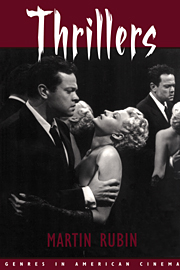Summary
The existence of critical and theoretical writings that deal explicitly with the thriller as a general category (rather than with one particular thriller-related genre, such as detective or horror) is limited. The majority of the few books that have been written on the general subject of the movie thriller - such as Brian Davis's The Thriller (1973), Lawrence Hammond's Thriller Movies (1974), and John McCarty's Thrillers (1992) - are primarily picture books that provide descriptions of several thrillers, with a minimal effort to define the underlying concepts that distinguish the thriller from other types of movies. More substantial approaches have been offered by academics Ralph Harper, Jerry Palmer, and, especially, Charles Derry.
Charles Derry, Ralph Harper, Jerry Palmer: Thrillers in General
In The Suspense Thriller (1988), Charles Derry, a genre-studies specialist who has also written books on the horror film and on the TV series thirtysomething, takes a taxonomic approach to the movie thriller: He is primarily concerned with classifying different categories of thriller rather than with tracing the historical evolution of the form. Derry limits his discussion of the “suspense thriller” to crime films that lack a central, traditional detective figure and that feature a protagonist who is either an innocent victim or a nonprofessional criminal (e.g., the scheming lovers of many a film noir). He excludes from his defined area several types of film to which the loose label of thriller has been frequently applied, including detective films (hard-boiled as well as whodunit - see Chapter 6), police films, heist films, horror films, and spy films whose hero is a professional spy.
- Type
- Chapter
- Information
- Thrillers , pp. 9 - 36Publisher: Cambridge University PressPrint publication year: 1999

